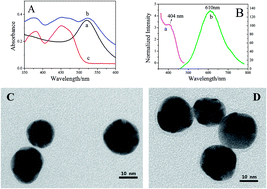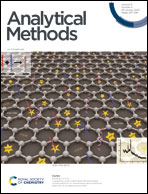An electrochemiluminescence sensor based on CdSe@CdS-functionalized MoS2 and a GOD-labeled DNA probe for the sensitive detection of Hg(ii)
Abstract
In this study, a novel electrochemiluminescence (ECL) biosensor based on a CdSe@CdS quantum dot (QD)-functionalized MoS2-modified electrode was developed for the sensitive detection of mercury ions. Polycationic poly(diallyldimethylammonium chloride) (PDDA) and negatively charged QDs were adsorbed on the surface of MoS2, in sequence, to form the QD–PDDA–MoS2 composites, which were employed as matrices for immobilizing thymine-rich DNA sequences (DNA1). The gold nanoparticles (AuNPs) were combined with another type of thymine-rich DNA sequences (DNA2) and glucose oxidase (GOD) to prepare the GOD–AuNP–DNA2 conjugates. The composites were characterized via UV-visible absorption spectroscopy, fluorescence and transmission electron microscopy. A thymine–Hg2+–thymine complex was formed through Hg2+ mismatching with DNA1 and DNA2. GOD was, therefore, modified onto the electrode surface. GOD catalyzed the reduction of dissolved oxygen by glucose to produce hydrogen peroxide, which was a co-reactant of the QDs. The electrochemiluminescence signal of the biosensor increased linearly with the increase in the Hg2+ concentration over the range from 1.0 × 10−12 to 1.0 × 10−6 M with a detection limit of 1 × 10−13 M. The reproducibility, stability and specificity of the biosensor was also studied. The biosensor was used to determine Hg2+ in a real water sample and satisfactory results were obtained.



 Please wait while we load your content...
Please wait while we load your content...